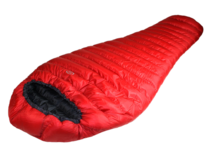The Lowdown
Extraordinary stories and technical knowhowCome on and get down (most of the time)

A quick word, if we may, about something which has been mentioned a few times to us recently: should you eschew down bags in favour of synthetics for UK camping?
It sounds like a simple enough question. And in reality, it pretty much is. The answer is no.
You were probably expecting more than that, weren’t you?
OK then.
To start with, what’s behind the question? Why the concern? Well, down fails if it gets drenched – the fluffy clusters collapse and can’t trap warmth – and it takes ages to dry (and that drying takes effort). Decent synthetics – like the Primaloft we use in our Zeta series bags – are more resistant to water, continue to offer some insulation when wet, and can be dried out far more easily anyway. That all being what it is, you’ll see why some are wary of using down in such a reliably unreliable climate as ours. Even though it’s lighter, more packable and longer lasting than the best synthetics, if it’s wet it doesn’t work. And working is pretty important.
Why did we say no then? The key is in the ‘if’. Down fails ‘if’ you get it wet. So don’t get it wet!
Seriously, keeping your down safe and dry needn’t be something to worry about. Keeping it dry when stowed is simple enough with a waterproof liner in your rucksack, and keeping it dry when camped isn’t a problem as long as you’re in some sort of shelter. Sure, if your breath condenses onto the bag and soaks through to the down (or if condensation dripping from the tent does the same thing) it could compromise the insulation, but that’s precisely why we use coated water resistant Drishell and Ultrashell fabrics.
We know what it is to camp in the damp of the UK, so these fabrics are available on even the lightest of our minimalist Minim series bags. Our very earliest pre-PHD beginnings were when Peter Hutchinson camped out in the north of England in the 1950s, and wished he had the equipment to deal with it!
So, although you may have heard that you simply don’t use down bags for UK camping because of the wet, the reality is that the amount of wetness necessary to cause problems isn’t a feature of normal camping. Pitch your tent in a water course or floodplain and you’ll have an issue, but that’s not really the fault of the bag, now is it?
We sense a question approaching…
Why do we make synthetic bags at all?
Yep, thought so! It’s a fair point. We think of them as climbers’ bivouac bags: bags for situations where you might not be able to avoid the wet. Even if you’re wild camping in wild weather, you can find somewhere to park yourself then unfurl your sleeping bag once undercover. If you’re improvising camp on a belay ledge though, you get what you’re given as far as location is concerned, and you might spend the night in the teeth of a storm.
This specialist usage was what we created our Zeta bags for, and that’s why they have things like cowl covers, and twin front zips to create armholes – so you can sit up and cook while still in your bag – which aren’t really necessary in a more conventional camping setup!
Back to the question which kicked this off then: should you eschew down bags in favour of synthetics for UK camping?
You can use synthetic bags – it won’t do you any harm – but do you need to? No, no you don’t.
Keeping your down safe and dry needn’t be something to worry about.
| Specialised Primaloft-filled bag for climbers' bivouacs in damp conditions.... |
| Specialised Primaloft-filled bag for climbers' bivouacs in damp conditions.... |
| Minimalist design cuts weight, but not warmth. For lightweight camping, mountain... |






















